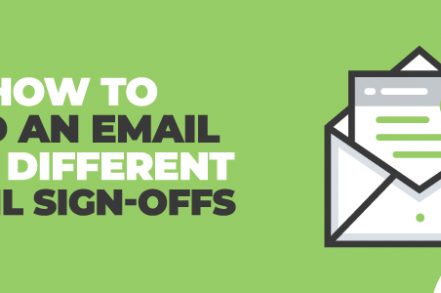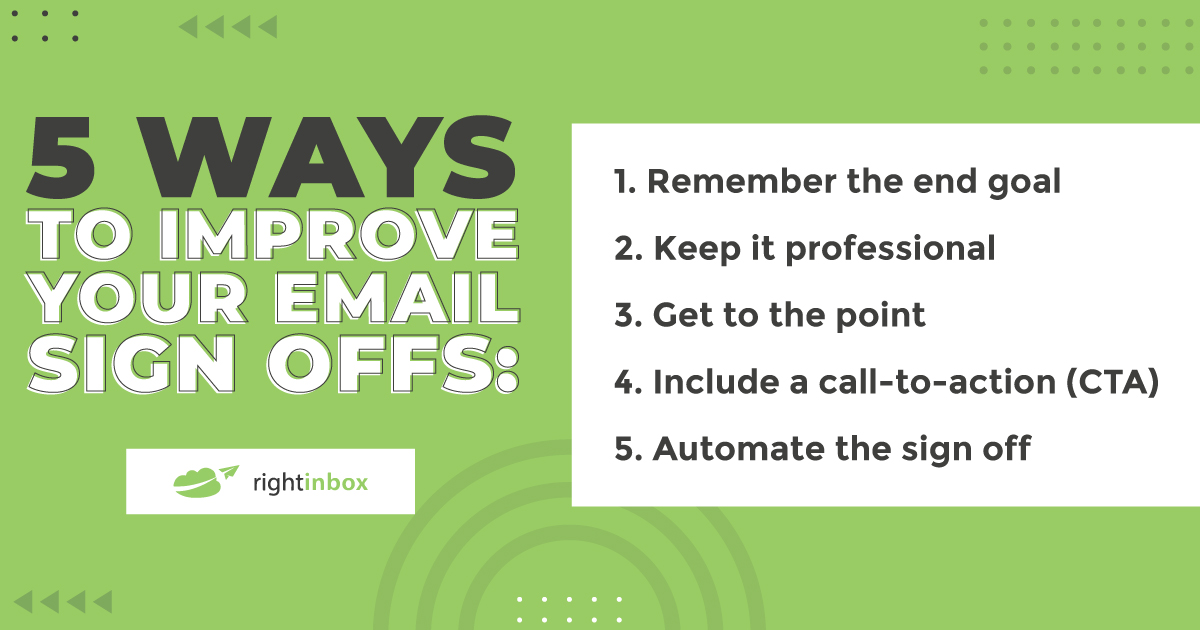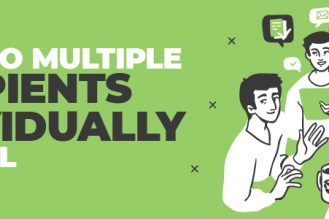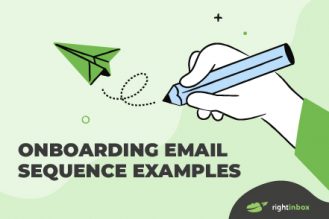When it comes to writing an email, there’s a lot more to it than you think. Sure, a great subject line, intro, and body are important. But you also need to finish your email strong.
Having a compelling email sign-off can set you apart from the crowd. It can also demonstrate your social savvy, professionalism, or unique value in the marketplace.
However, it’s easier said than done. So let’s talk about how to end an email powerfully.
5 ways to improve your email sign offs:
- Remember the end goal — remind the recipient of the main theme of your email in a way that moves the conversation toward that aim.
- Keep it professional — when in doubt, don’t be too casual with someone unless you have a developed personal relationship with them. Being too professional never loses anyone an opportunity.
- Get to the point — avoid sign offs that wind on and on. Summarize your points and let the body of your email do most of the talking.
- Include a call-to-action (CTA) — what are you hoping for in response to your email? Should they click a link, sign up for a service, or give you a phone call? Don’t expect your recipient to read your mind.
- Automate the sign off — using an email app like Right Inbox helps you save your creative juices for the content of the mail, while automating your sign off and signature.
75 Different Email Sign-Offs
- Thank you
Not only does gratitude help lift your mood and improve your outlook on life, it can also help you win new friends.
- Best regards
If you’re sending a more formal email – perhaps a note to your new boss who’s just been hired – you can’t go wrong with the formal but sincere “Best regards.”
- Happy Friday
You can substitute any other day of the week, of course, but somehow “Happy Monday” just doesn’t quite have the same ring to it.
- Cheers
“Cheers” is a good multipurpose closer that works well whether you know the person you’re communicating with personally or not.
- Take care
This is probably best used as a closing phrase for a colleague that you know and genuinely care about.
- Speak soon
If you’ve just scheduled a meeting or you know there will be many more back-and-forths about a project, close with “speak soon.”
- Looking forward
Again, use this if you’ve just scheduled a meeting or you’re waiting on a deliverable.
- Yours
This one might be a little strange for a business email, but if you feel it’s appropriate, go for it.
- Much appreciated
Remember, when in doubt, show a little gratitude. Everyone likes to hear that their efforts are seen and appreciated.
- Until ____
Fill this in with the next time you’re planning to see or speak to your recipient: “Until tomorrow,” “Until then,” or “Until next Friday.”
- Respectfully
“Respectfully” is best used when you’re writing to a higher-up in the company.
- Have a great day
This is a friendly, upbeat way to close an email. You can also substitute “Have a great weekend” or “Have a great holiday.”
- Cordially
Communicating with someone you don’t know very well? In most cases, it’s better to be polite than casual.
- Enjoy your ____
Again, fill in the blank with whatever is appropriate: “Enjoy your day,” “Enjoy your weekend,” etc.
- Hope this helps
Best used when collaborating on a project or answering a list of questions.
- Let me know if you need anything else
A little wordy, but it’s important to make people feel like they can freely ask you whatever questions they have, without feeling like they’re imposing.
- Pleasure
For when you’re catching up with an old colleague or having an enjoyable, in-depth conversation with someone.
- I owe you
Has someone done something really special for you? Tell them you’re in their debt – and don’t forget to follow through.
- Thanks a million
Casual and friendly, this is for the true-blue coworkers who’ve bailed you out of hot water.
- Kind regards
Depending on the context, this could come across as either stuffy or friendly, so use with care.
- Sincerely
This isn’t extremely common in the business email world, but it could work in some situations.
- Warmly
“Warmly” is a nice way to end an email and bring, well, a warm and fuzzy feeling to your recipient.
- Keep on keepin’ on
This email sign-off is casual, fun, and best used in settings that are the same.
- Looking forward to your reply
If you’re not sure the person you’re emailing is going to respond, throw this in as your closing – they’ll feel more obligated to click ‘reply’.
- Fond regards
Keep this one in your back pocket for non-casual settings.
- Thanks for your consideration
Sending a proposal or applying to a job? Don’t forget to thank the recipient for their consideration.
- Thanks for your time
The person you’re emailing didn’t have to take the time to read through your email, but they did. Say thanks!
- With anticipation
Excited about getting a reply? Close by saying “With anticipation.” (Best used when discussing the office Taco Tuesday.)
- Keep in touch
Maybe you’re not planning to speak regularly with the person you’re emailing – if so, close with a general “keep in touch.”
- Good luck
Does someone have a big project or proposal coming up? Wish them well.
- Keep me posted
End with a nice reminder for your recipient to keep you in the loop.
- I’ll circle back
Can’t answer their question right away? Reassure them that you will.
- Stay tuned
If you’ve got exciting things coming and you want your recipient to know, close with “stay tuned.”
- Good work
If someone is working for you, give them feedback and appreciation.
- Hope all is well
Best used for someone you haven’t spoken with in a while.
- Pleasure working with you
This is a friendly way to close an email and ensure you’ll work with this person again.
- Hasta la vista
Casual email to a coworker you know well? Channel your inner Schwarzenegger.
- Safe travels
Only appropriate, of course, if the other person is traveling. It’s a nice way to wish them well.
- Rock on
This fun email sign-off is applicable in other settings besides just the music world.
- Thanks in advance
If someone promises to do something nice for you (or you’re hoping they will) – thank them now.
- Happy to help
You answered a question, worked on a project, or saved a life. Reassure the other person that it was your pleasure.
- Keep being awesome
Do you think someone you work with is pretty awesome? Tell them – and tell them to stay that way.
- At your service
Remind people you’re here to help.
- Hope you can make it
Planning a meeting? An office party? Tell people you want them there.
- Feel better soon
If someone is complaining about a cold, take notice and end your email with this sign-off – people remember the little things like that.
- Keep up the great work
This sign-off is meant for someone who’s doing work for you and killing it.
- To your success
Remember, email sign-offs aren’t about you; they’re about the other person.
- Congratulations
Again, don’t be afraid to recognize the other person’s accomplishments.
- Stay warm
If you’re having a cold snap, close emails with “stay warm” (as long as the recipients live in the same area as you). What would we do without the weather as a conversation starter.
- Get ready
Big things coming? Advise the other person to hang on to their seat.
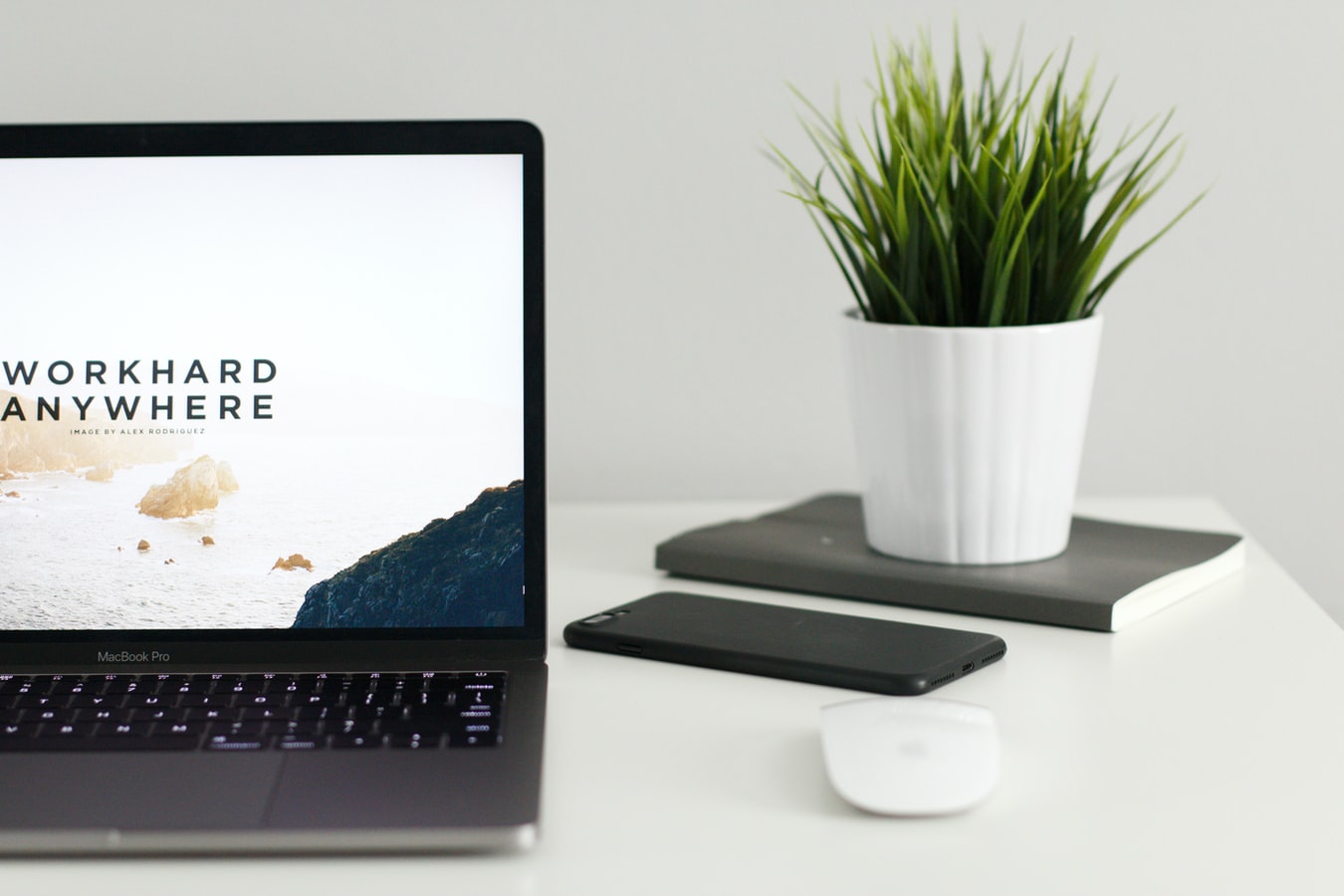 51. All the best
51. All the best
This is a positive yet neutral sign off – it works for multiple occasions!
52. Wishing you the best
Similar to the above, although it’s a little more personal in nature.
53. Have a fantastic day
Everyone loves to have a fantastic day. No matter who you’re talking to, it will be well received.
54. Take it easy
This is particularly powerful if you have just finished a long work session or project with a colleague or coworker. It can also be used if someone is recovering from a difficult situation like a surgery.
55. Looking forward to connecting
This is perfect if you have not had the opportunity to meet the person or have a conversation with them yet.
56. Until our paths cross again
If you have seen someone and are going to meet up again, this signoff sets the expectation clearly and directly.
57. In your service
Humility is a virtue.
58. Sending positive vibes
A somewhat modern saying, this works for certain demos.
59. Best wishes on your endeavors
If the recipient has shared certain plans or dreams with you, then this signoff is great.
60. Keep shining
Sort of cheesy, but will land wonderfully with the right recipient.
61. Have a wonderful week
A Monday or Sunday signoff is great for this. It wouldn’t make as much sense on a Thursday.
62. Until we meet again
If you’re seeing the person tomorrow, then avoid this. However, if you are going to wait months or years, then this signoff is appropriate.
63. Stay inspired
A great signoff for speakers, coaches, consultants, and anyone who has the task of inspiring or teaching others.
64. Sending warm thoughts
While it’s never bad to send warm thoughts, this is best reserved for more serious situations like illnesses.
65. Onward and upward
If the recipient has just overcome a difficult situation, then using this can lighten their spirits.
66. Cheers to your success
Great for celebrating a recent accomplishment like a promotion or newly won sale.
67. With appreciation and gratitude
If someone made time to meet with you or otherwise helped you, then showing gratitude will always be appreciated.
68. Sending good vibes your way
Who doesn’t love good vibes? Just keep in mind the age of the person you’re sending it to.
69. Here’s to a bright future
For young recipients, this is a great way of wishing them well. After all, they have a long future ahead of them.
70. Keep up the amazing work
If you have hired someone to complete work, then it’s always great to encourage them. Sometimes this is worth more than money itself.
71. Wishing you joy and fulfillment
An excellent signoff during the holidays or for those you are very close to personally.
72. Stay motivated and driven
Send this to salespeople, up and comers, or anyone else who needs an emotional boost to stay effective.
73. Take care and stay well
This is generic. However, it works for virtually anyone who you could send an email to whether personal or professional.
74. Embrace the journey
Implying that there is a journey ahead, reserve this signoff for challenging trials. For instance, if someone must go through a grueling practice schedule to get ready for the season ahead, this email would work.
75. Have a memorable day
Unique and powerful, this signoff isn’t something you see every day.
Anatomy of an Email Sign Off
An email sign off is much more than just a signature, contrary to popular belief. In fact, there are three primary elements to a great email sign off: your finishing thoughts, the sign off itself, and your email signature.
Let’s explore each element so you can create professional, engaging emails that further your goals:
Finishing Thoughts
Simply put, the finishing thoughts are the last sentence or two that conclude the body of your email.
It’s often best to use these closing remarks to summarize the main point of your email, or emphasize your excitement for the topic in the email. Some examples of finishing thoughts are:
“Thank you again for your consideration! Looking forward to our interview on Monday.”
“It was great meeting you. If you have any other questions regarding our proposal, you can reach me here or by phone at your convenience.”
“With all of that in mind, I hope you will reconsider canceling your contract.”
The Sign Off
The sign-off is the opposite of a greeting. Instead of “Hello”, you can leave a simple word or phrase to indicate the email is finished. Some classic examples are: “Sincerely,” “Best regards,” and “Cheers.”
The Signature
The final component of your email is the signature. This includes your contact information and potentially relevant links such as your website or social handles. Aim to include some or all of the following in your signature:
- Name
- Title
- Number
- Professional Bio
- Social Media Links
5 Do’s and Don’ts of Email Sign Offs
Email Sign Offs Do’s:
1. Be Grateful
People respond to gratitude. It makes them feel appreciated and valued, and, according to a survey, an email sign-off that includes a “thank you” receives a response rate 36% higher than other sign-offs.
2. Personalize
Tailoring email content and subject lines has been proven to improve open rates. So, whether you’re sending an email to a single recipient or a mass email campaign to your contact database, it’s always a good idea to personalize your email sign-off. Most email marketing software will allow you to personalize elements of your emails, including the recipient’s name, salutation, and company name.
3. Ask for a Single Action or Reaction
If you’re looking for your email recipient to respond to your email or go on to take an action, the best place to ask is in your sign-off. But be careful: emails that include a single CTA elicit 371% more clicks than those with several, so make sure you don’t ask too much from your recipients.
4. Make it Easy for Them to Contact You
If you’re expecting your email recipients to keep in touch, provide a few ways in which they can get hold of you. In addition to your full name, you should provide your email address (don’t rely on them hitting “reply”), a direct phone number, your LinkedIn profile (and one or two other social profiles), and your company website.
5. Make it Match Your Greeting
It’s a good rule of thumb to keep your emails consistent, with the tone of the sign-off reflecting the same tone as your greeting and body content. If, for example, you begin with “Hey Dan,” it would be somewhat strange to sign off with “Sincerely.”
Email Sign Off Don’ts:
1. Forget the Sign-Off
An email without a sign-off is like a story without an ending. Not only does it mark the end of the message – giving your recipient no doubt that they’ve received it in its entirety – but it’s also a sign that you’ve put thought and effort into your note. Receiving a message that ends with “Sent from my iPhone” might give the impression that you’re dashing out a quick memo without giving it your full attention.
2. Be Over-Familiar
Business emails aren’t the place for colloquial sign-offs such as “xoxo,” or abbreviations like “Thnx.” If you’re unsure of how formal to go with your emails, always err on the side of being more formal rather than not enough.
3. Ignore the Context
Context is everything when it comes to signing off an email. Think about your relationship with your recipient: How well and how long have you known them? What’s the nature/purpose of your email? How formal is the company they represent? Try to match the tone of your sign-off with the context in which you’re writing it.
4. Distract with Graphics
Including a company logo in your signature is one thing, but when it’s so large that it takes up half the screen, it can be distracting. Keep any extraneous visuals, links, etc. to a minimum to retain the punch of your message.
5. Churn Out the Same Sign-Off Every Time
Using one standard sign-off for every email will save you a lot of time. That said, it won’t make the most of the sign-off’s potential to build relationships, encourage an action, and form a lasting impression of who you are as an individual or business.
Bonus Tip: Leaving a Strong Lasting Impression
As mentioned, the way you sign off your email will have an impact on how your recipients will remember you. That’s why it’s important to have a strong email signature. Get more email replies and leads with the perfect email signature for every context. Having multiple signatures with slightly different information can help you close that deal or get your PR pitch featured on a site.
The key is to find the right combination of visuals, information, and calls-to-action to provide your recipients with options without overwhelming them.
Additional Reading: How To End A Business Email (With Examples)
Track emails, email reminders & templates in Gmail for free
Upgrade Gmail with the features it’s missing
Add to GmailDavid Campbell
David Campbell is the editor of the Right Inbox blog. He is passionate about email productivity and getting more done in less time.
